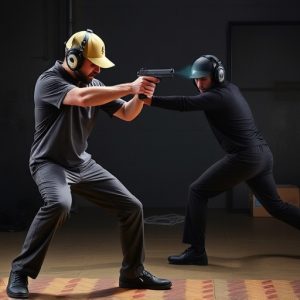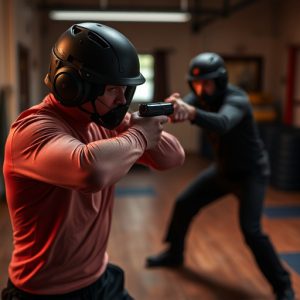Lipstick-Sized Stun Gun vs Taser: Key Differences & Legal Insights
Tasers and stun guns, though both non-lethal, differ in mechanism (probes vs. high-voltage pulses) a…….
Tasers and stun guns, though both non-lethal, differ in mechanism (probes vs. high-voltage pulses) and size. Stun guns, like a lipstick-sized device, are compact, easily concealed, and accessible for personal safety. Tasers are bulkier, with longer probe ranges but require trigger pulls. In terms of regulations, Tasers are generally easier to own due to their classification as Electronic Control Devices, while stun guns often fall under stricter rules as firearms. The choice depends on individual needs; stun guns offer discreet, powerful protection suitable for everyday carry, while Tasers have broader law enforcement applications. Proper training and legal awareness are vital for safe use of these compact self-defense tools.
In today’s world, personal safety is paramount. Understanding the differences between Tasers and stun guns—especially their compact variations like the lipstick-sized stun gun for purse—is crucial. This article provides a comprehensive overview of these non-lethal self-defense tools. We explore key distinctions in size, portability, operation, legal considerations, and safety to help you make informed choices. Discover which tool might best suit your needs while navigating the fine line between protection and potential risks.
- Understanding Tasers and Stun Guns: A Basic Overview
- Size and Portability: Lipstick-Sized Stun Gun vs Taser
- Operation and Activation Mechanisms
- Legal Considerations and Use Cases
- Safety, Efficacy, and Potential Risks Compared
Understanding Tasers and Stun Guns: A Basic Overview

Tasers and stun guns are non-lethal weapons designed to incapacitate individuals temporarily, but they operate through distinct mechanisms. Tasers, officially known as Conducted Electrical Weapons (CEWs), fire two thin probes connected to wires that deliver an electric current across the target’s body. This causes muscle contractions, disorienting the individual and rendering them temporarily immobile. On the other hand, stun guns use high-voltage, low-amperage electrical pulses to disrupt the nervous system, resulting in a similar loss of control and mobility.
While both devices aim to subdue attackers, their portability differs significantly. A lipstick-sized stun gun designed for a purse offers discreet self-defense, making it easily accessible. In contrast, Tasers are generally bulkier and not as easily concealed, though they provide a more powerful jolt. Understanding these differences is crucial when considering the best option for personal safety based on one’s needs and preferences.
Size and Portability: Lipstick-Sized Stun Gun vs Taser
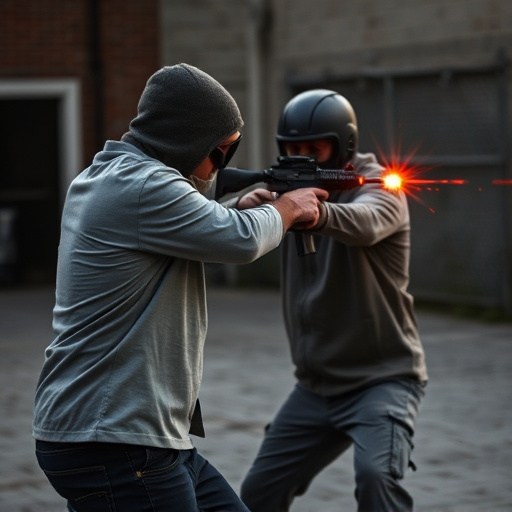
When it comes to size and portability, the lipstick-sized stun gun stands out as a compact self-defense option that easily fits in your purse or pocket. Its small dimensions make it an attractive choice for individuals seeking an invisible yet powerful personal safety device. In contrast, Tasers, while also relatively portable, tend to be bulkier and may not discreetly fit into everyday carry items like a lipstick stun gun.
This size difference has practical implications. A lipstick-sized stun gun allows users to have a quick and easy access tool for self-defense in close-quarters situations. Its compact nature makes it an ideal backup option for those already carrying pepper spray or other self-defense devices, providing an additional layer of protection without adding significant bulk to their everyday carry gear.
Operation and Activation Mechanisms
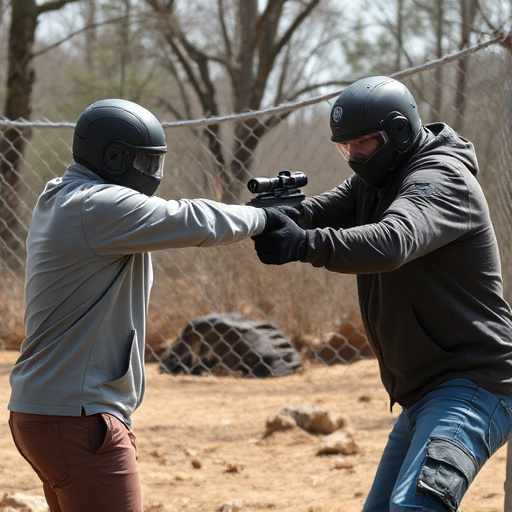
Tasers and stun guns are both non-lethal weapons designed to incapacitate an opponent, but they operate and activate in distinct ways. A taser uses electrical arcing and probes to deliver a high-voltage, low-current electric shock, temporarily paralyzing the target. Users typically need to make physical contact with the victim, and the device fires two thin probes connected to wires, which can be up to 30 feet long. In contrast, a stun gun uses electrical current to disrupt muscle control, causing severe pain and temporary paralysis. Stun guns often resemble firearms or flashlights and require the user to press a trigger to deploy an electric pulse. Some models, like a lipstick-sized stun gun for purse, are designed to be easily concealable and activated by a simple pressure or twist mechanism, making them accessible for personal protection.
The activation process varies as well; tasers usually require the user to pull a trigger after firing the probes, while stun guns often use a push-button or twist mechanism. Stun guns generally have a shorter range compared to tasers, and their effectiveness can be influenced by weather conditions or the target’s body armor. Additionally, stun guns may produce a brighter flash of light and a louder sound, making them more noticeable than tasers in certain situations.
Legal Considerations and Use Cases
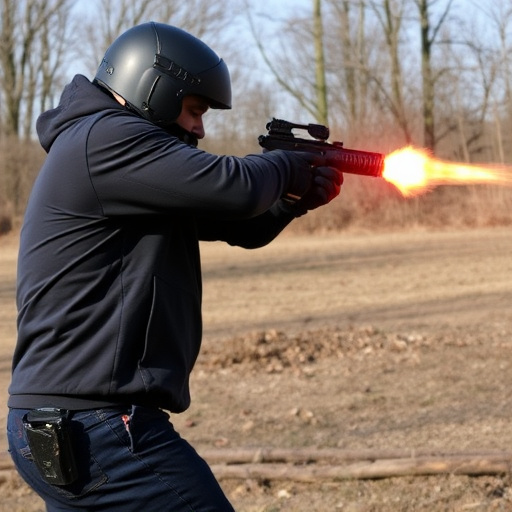
In terms of legal considerations, both Tasers and stun guns are subject to specific regulations that vary widely across jurisdictions. One notable difference lies in their classification as firearms or non-lethal weapons. Tasers, officially known as Electronic Control Devices (ECDs), are typically classified as less lethal instruments designed to temporarily incapacitate individuals through muscle paralysis. On the other hand, stun guns, often referred to as electroshock weapons, are usually considered firearms due to their use of high-voltage electrical currents to disrupt motor functions. This classification significantly impacts their legality—Tasers generally require less stringent permits or regulations for ownership and carry, while stun guns may be subject to stricter controls and restrictions.
Use cases also differ between these two devices. Tasers are often employed by law enforcement agencies as a non-lethal means of self-defense against resistant suspects, offering a tool to control and subdue individuals without causing permanent harm. Conversely, stun guns, due to their compact size, like the lipstick-sized option designed for purses, cater more to personal protection. They are popular among individuals seeking an easily concealable device for self-defense in situations where they might face physical threats or attacks. This distinction in use cases further underscores the different legal landscapes surrounding Tasers and stun guns.
Safety, Efficacy, and Potential Risks Compared

When comparing a Taser and a stun gun, understanding their safety features and potential risks is crucial. A lipstick-sized stun gun for purse, due to its compact nature, often focuses on delivering a powerful but localized shock, aiming to incapacitate an attacker temporarily. These devices typically use high voltage, low current electrical discharges to disrupt muscle control without causing severe injury. However, their effectiveness can vary based on factors like range, contact points, and the individual’s tolerance to pain or fear.
In terms of safety, both weapons have their considerations. Stun guns are generally perceived as safer because they require direct contact to be effective. Yet, Tasers fire small probes that can penetrate clothing and cause more widespread disruption, potentially increasing the risk of collateral damage. Moreover, improper use or a weak charge could lead to reduced effectiveness. It’s important for users to receive adequate training and understand the legal implications to minimize potential risks.
In comparing taser and stun gun differences, particularly considering a compact, lipstick-sized stun gun designed for purses, it’s clear that both devices serve as powerful personal safety tools. Understanding their unique operation mechanisms, legal landscapes, and potential risks is crucial for informed decision-making. While a stun gun offers a straightforward, high-voltage jolt, tasers employ a complex web of electrochemical pulses to disrupt muscle control. The choice between them depends on individual needs, with factors like size, portability, and specific use cases playing significant roles. For those seeking maximum discretion and ease of carry, a lipstick-sized stun gun may be the preferred option.
